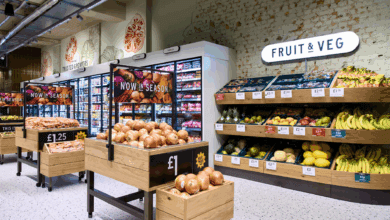How the US tariffs could redefine the future of UK retail
As global trade faces new challenges, retailers must navigate the complexities of changing tariffs and their impact on the industry. Retail Sector spoke with experts to understand how tariffs are reshaping the sector, what businesses can do to adapt, and the future outlook for international trade

The UK retail industry is bracing for disruption as the US prepares to enforce a sweeping set of tariff increases, marking what experts are calling the most consequential shift in global trade policy in over a century. With economic, operational and consumer-facing impacts already being felt, British retailers must now navigate a radically changing export landscape, with particularly stark implications for luxury brands, direct-to-consumer (D2C) merchants and those heavily reliant on Chinese manufacturing.
“This is the single biggest economic policy change in living history,” says Cristian van Tienhoven, CEO, Europe at Global-e. “The tariff increases announced are the highest since 1909.”
What’s changing and why it matters
The Trump administration’s tariffs target a broad range of imports, with new emphasis on goods from China. A notable shift is the potential removal of the de minimis threshold for low-value goods from China, which currently exempts shipments under $800 (£598) from import duties. If enacted on 2 May, as planned, this move would send shockwaves through the retail supply chain.
“The dramatic tariff increases to products with country of origin China, and the end of the de-minimis threshold for these products, should it go into effect on 2 May as announced, could heavily impact retailers globally,” says van Tienhoven. “This will especially affect merchants selling products with China as a Country of Origin, and retailers of high-value goods.”
Though UK exports to the US comprise a relatively small slice of overall sales, the strategic importance of the American market cannot be overstated. “The US is the UK’s largest non-EU export market, which makes Trump’s moves strategically disruptive – particularly post-Brexit, when many brands recalibrated towards US expansion,” says Nicholas Found, head of commercial content at Retail Economics.
Supply chain paralysis
The introduction of tariffs has led to uncertainty, stalling strategic planning and threatening profitability across the board.
“It remains to be seen how the new global tariff landscape will look,” van Tienhoven notes. “The tariff situation has created a lot of uncertainty and unpredictability for brands, which can paralyse them from making their next move. This really hammers home the importance of agility.”
For high street retailers, the impact is currently more psychological than direct, but that could change if tariffs persist or escalate. “In the short term, few high street retailers are directly impacted, as most do not have significant exports to the US,” says Found. “More concerning than direct impacts is the wider ripple effect across investor confidence, supply chain recalibrations and hesitancy in capital investment.”
Sofie Willmott, director of insight at Retail Economics, adds that retailers are already contending with a volatile macroeconomic environment. “With fragile consumer confidence, cost pressures and demand weakening, the addition of new tariffs could be the tipping point that forces retailers to reassess their business models and international strategies.”
The immediate dilemma for retailers lies in pricing. While many consumers are highly price-sensitive due to the cost-of-living crisis, absorbing tariffs outright may not be sustainable.
“Retailers are deeply reluctant to pass further costs onto consumers,” says Found. “However, premium and luxury players exporting to the US are likely to pass a proportion of tariff costs onto American consumers.”
Van Tienhoven agrees: “No direct-to-consumer brand has the margin to absorb the announced tariff increases for products with country of origin China, currently resulting in a total increase of 145%. On the other hand, passing all costs to the customer is not ideal and could impact sales.”
The key, he says, is to strike a balance that preserves conversions and customer trust. “Online shoppers want to know that they can buy from a webstore, regardless of where the brand is based, without unexpected costs upon delivery.”
Legal experts warn that the changing regulatory landscape requires swift strategic adaptation. Russell Moore, legal director at transatlantic law firm Womble Bond Dickinson, recommends that retailers evaluate their customs and logistics infrastructure.
“The availability of remedies that UK retailers can use to counteract tariff impact will depend on the terms of their trading contracts, since these will specify their rights and obligations of the parties in respect of the tariffs,” he advises.
“Any decision on investment will need to ensure that cost, quality and time to market are balanced – UK manufacturers may seek to highlight their strengths in balancing and protecting these key requirements as a strategic partner in a global supply chain network,” he adds.
The luxury brand squeeze
Luxury brands are among the hardest hit, not only due to their heavy reliance on the US market but also because of the brand equity risks involved in uneven price adjustments.
“These brands are on the front line,” says Found, referencing major names like Burberry, Stella McCartney and Alexander McQueen. “With the US making up a significant share of sales, tariffs risk reducing price competitiveness, slowing US growth, and disrupting retail investment plans in major cities such as New York and LA.”
Luxury retailers are also limited in how far they can go in absorbing the costs. “There is more room to manoeuvre in luxury than in mass retail, but margins are not limitless,” says Found. “If heightened tariffs persist, the most likely path in the short term is a combined margin hit, operational adjustments, and targeted price increases for US customers.”
This presents a branding risk. “If prices rise unevenly across different markets, it risks encouraging cross-border shopping and resale arbitrage, complicating global positioning,” Found warns.
Even so, luxury brands retain a strong appeal in the US. “British luxury brands trade heavily on craftsmanship, heritage and exclusivity, which are valued by US consumers,” says Found. “However, prolonged price divergence or limited availability could see some trading down. Messaging and customer engagement will be critical to maintain brand equity.”
From China to the world
With China being such a central point of manufacturing for many brands, the new tariffs could accelerate diversification efforts. But this shift is neither easy nor immediate.
“Moving manufacturing away from China isn’t simple, as the tariff implications for all countries are so uncertain,” says van Tienhoven. “It’s creating a paralysis moment for brands.”
Instead, retailers may explore more agile models. “A B2B2B2C model (which we simply call 3B2C) could help limit the impact of the new tariffs on costs as it enables D2C merchants to import goods to the USA as a wholesaler, at wholesale rates, and turn the B2C transaction into a domestic one,” he explains.
In the longer term, multi-sourcing and nearshoring are likely to gain traction. “We’re likely to see more multi-sourcing, nearshoring, and the use of US-based distribution hubs as contingency planning accelerates,” Found notes.
While the US remains indispensable, brands are eyeing other growth markets to hedge their bets.
“Brands will likely de-risk their growth strategies by diversifying into markets such as the Gulf, Southeast Asia and Australasia, where consumer appetite for British brands remains strong and tariff stability more certain,” says Found.
Van Tienhoven echoes this, noting that “the global cross-border e-commerce market is growing rapidly, and many regions offer new growth opportunities. The ability to sell efficiently to long-tail markets is more important than ever before, as collectively they could become a significant revenue stream.”
A call for action
Across the board, the message is clear: agility, preparedness and diversification will be essential for navigating the new tariff landscape. Whether it’s high-street brands juggling cost pressures and shifting supply chains, or luxury houses safeguarding brand equity while navigating pricing strategy, UK retailers must act with urgency and precision.
Tariffs may be headline-grabbing, but the ripple effects across operations, investment, international growth, and customer trust are equally profound. Retailers with the agility to adapt, the foresight to diversify, and the infrastructure to scale globally will be best positioned to weather this storm.
Whether through cross-border e-commerce, domestic US operations, or diversified market expansion, the choices made now will shape not just survival, but long-term relevance on the global stage.
As Found puts it: “Scenario planning will be essential. Retailers must model for multiple trade outcomes – from prolonged tariffs to possible retaliatory measures or exemptions. The key is to stay flexible, lean and globally minded.”







